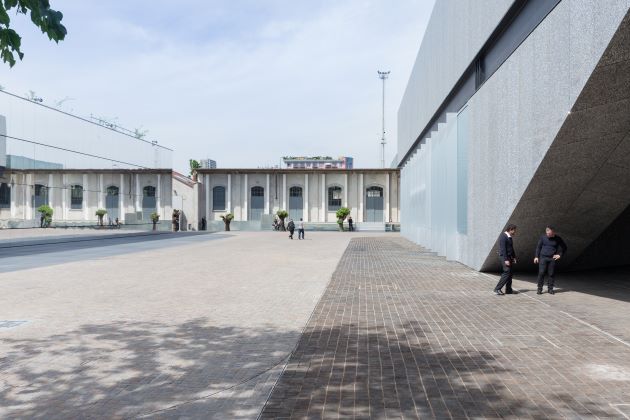![]() Roof of the Duomo. Photo by Daniel Case
Roof of the Duomo. Photo by Daniel Case
Every April, designers, architects, brands and the media descend upon Milan for the biggest event in the design calendar. Milan Design Week, which includes Salone del Mobile, the furniture fair, Euroluce, the lighting exhibition, and the Fuorisalone exhibitions and installations, is the time designers across the board to showcase new works, launches, innovations and collaborations for the upcoming year.
Outside the design week, Milan remains a design hub and home to many an iconic structure that visitors to the fair will inevitably pass by on their journeys round the fair. Here, we round up some of Milan’s most iconic buildings and towers.
Duomo
![]() The Duomo piazza. Photo via Wikimedia Commons
The Duomo piazza. Photo via Wikimedia Commons
Italy’s largest cathedral is in the heart of Milan, its imposing pinnacles and spires some of the best known architectural features in the city. Construction of the huge church took place over seven centuries, beginning in the 1300s, with some of the last additional parts added in the 1960s. More recent renovations have cleaned and exposed more of the pinkish marble, and a new LED system to light up the interior and exterior more energy efficiently has been installed over recent years. Tourists can climb onto its roof to admire more of the decorative sculptures not visible from the ground, and for impressive views over the entire city.
Fondazione Prada
 Fondazione Prada. Photo by Iwan Baan
Fondazione Prada. Photo by Iwan Baan
The cultural institution set up by Miuccia Prada and Patrizio Bertelli gained a new permanent space in Milan in 2015. The Largo Isarco venue, a gin distillery from the early 20th century, was adapted and extended by OMA, combining the old buildings with new extensions that house a cinema and gallery. The on-site cafe is worth a visit alone, with interiors designed by film director Wes Anderson, and inspired by the city’s 1960s cafes with the signature Anderson pastel tones.
 Fondazione Prada. Photo by Iwan Baan
Fondazione Prada. Photo by Iwan Baan
The latest exhibition, showing 6 April to 5 August 2019, features a multimedia installation across the majority of the venue by Lizzie Fitch and Ryan Trecartin, who explore ideas around borders and territorial appropriation.
Galleria Vittorio Emanuele II
![]() Galleria Emanuele Vittorio II. Photo by Fernando Meloni
Galleria Emanuele Vittorio II. Photo by Fernando Meloni
The ornate glass roof of this 19th-century shopping arcade is one of the Milan’s highlights. The arcade stands four storeys tall, imposing archways at each of its openings. Inside the ‘salotto di Milano’ – or salon of Milan – there are a variety of high-end boutiques, such as Italian brands Prada and Gucci. And, as the galleria’s own site describes, there’s also a ‘surprising’ McDonalds alongside the traditional Milanese restaurants.
Bosco Verticale
![]() Bosco Verticale. Photo by Ricardo Gomez
Bosco Verticale. Photo by Ricardo Gomez
The Bosco Verticale, or “vertical forest”, by Italian architect Stefano Boeri is in the north of the city centre, a pair of towers notable for their extremely green exterior. They were designed as sustainable residential buildings, covered on their facades by hundreds of trees that help improve air quality and biodiversity in the area, and they won the prize for Best Tall Building Worldwide in 2015. Though located in a business district, the towers attract visitors keen to photograph the greenery against Milan’s frequently bright blue sky.
UniCredit tower
![]() UniCredit tower in Milan. Photo by Julien Rocheblave
UniCredit tower in Milan. Photo by Julien Rocheblave
The tallest building in Italy was designed and built around the same time as the Bosco Verticale, a time of transformation for several parts of the city. The UniCredit tower is the HQ of the Italian bank, designed by Cesar Pelli and located in a large business development in the Porta Nuova district. The exterior of the building is covered in LEDs and curved glass, allowing it to represent a range of designs – it has frequently been used as a site of commemoration and solidarity, being lit up with flags of countries and groups attacked by extremists around the world.
Pirelli Tower
![]() Pirelli Tower. Photo by IK’s World Trip
Pirelli Tower. Photo by IK’s World Trip
Gio Conti’s skyscraper for the Pirelli industrial family is a modernist icon in Milan. The tower was completed in 1958, built on the former site of a Pirelli factory, the first building to surpass the Duomo in height. Its tapered sides proved an inspiration to other skyscrapers, including the Pan Am building in New York and it featured in the opening credits of Michelangelo Antonioni’s La Notte, the camera tracking down the length of the building. Now it’s home to Lombardy’s Regional Legislative Assembly meetings and occasionally opens its observation deck to the public on special event days.
















